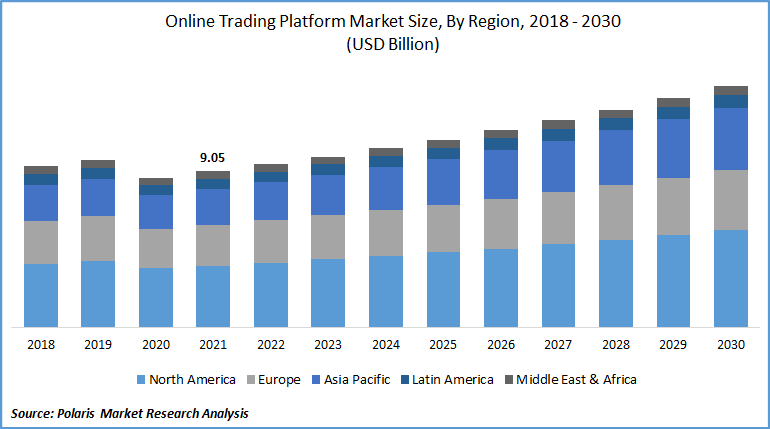5 Trends In Trading Platform Development
In the world of trading, you can’t afford to be left behind. The evolving landscape of trading platforms is a testament to this fact. The days of plain text terminals displaying only market data are long gone; now you have tools that provide insights into your portfolio and make it easy to execute trades with just a few clicks.
Advanced charting tools are an essential part of robust banking services and if you wish to develop finance software or Forex solutions then such charting is extremely effective. A few years ago, traders had to rely on Excel charts and third-party software for creating charts, as there were no built-in tools available. But now, every trading platform offers a charting tool with a wide range of technical indicators and drawing tools.

Most charting tools are also accompanied by advanced order placement options that help traders quickly submit orders from the charts themselves. Here are five key trends in trading platform development that will set the stage for future innovation.
Top five trends in trading platform development
1. Progressive Charting Tools
The trading industry has been gradually moving away from standard charting to more interactive, user-friendly, and customizable tools for traders. Interactive charting allows traders to view real-time charts of Forex and other financial assets, as well as trade directly from their charts using a single click. The automated calculations of technical indicators on a chart enable traders to make better decisions when trading, as well as save a lot of time spent on manual calculations.
To use charts effectively, you need a powerful charting program that allows you to choose different timeframes, indicators, and drawing tools. The latest generation of charting tools takes this one step further by allowing you to add different layers on top of existing charts — everything from volume profile bars and indicator overlays to live candlestick pattern recognition. If you’re using a state-of-the-art platform, you’ll be able to compare performance across multiple instruments at once and switch between different timeframes with just a click or two.
But it’s not enough to just graph numbers; you also need to show them in the context of the market. For example, the trading app must display a history of highs and lows, as well as support trading indicators, like moving averages, Bollinger bands, Fibonacci retracement levels, and so forth.
2. Customizability & Flexibility
Today’s trading platforms are built for a wide array of traders — from large institutions to small retail investors and also trade a variety of financial assets, such as stocks, bonds, currencies, and commodities. They have to be flexible enough to meet the demands of all these different customers, which is why ease of customization has become a major theme in trading platform development. Being highly customizable allows users to set up their trading strategies and signals
A good trading platform offers opportunities for customizing its interface, as well as for automating trading operations.
You will have to spend time adding features that enable the development of custom trading strategies and signal groups. This functionality should include:
- The ability to create one’s indicators based on user-defined formulas.
- The ability to create custom templates for charts.
- The ability to set up automated notifications about potential trading opportunities.
- The ability to create one’s trading signals.
In the past, traders were forced to choose between a custom-built solution and a generic one-size-fits-all platform. Today, the middle ground is rapidly expanding, allowing traders to get the best of both worlds by mixing and matching features. The ability to customize their trading experience is essential for businesses seeking an edge in the marketplace, and we expect this trend to continue growing in 2022 and beyond.
3. High-Speed Operations
As the market becomes more competitive, traders need to take advantage of every opportunity they have. To do so, they need software that can process large amounts of data in a short time. This is the area where the biggest changes are taking place at the moment.
Trading platform development has undergone a massive transformation over the last few years. The share of high-frequency trading (HFT) operations has grown significantly in the recent past. This is mainly because traders are becoming more tech-savvy and prefer HFT to traditional trading methods.
Some companies are already offering platforms that can execute thousands of trades a second, which means that traders can make decisions much faster than before. In this way, they can take advantage of even the smallest market movements.
Of course, this doesn’t come without its risks. Since traders don’t have much time to analyze the data before making their decision, they run the risk of making mistakes if they rely on faulty information or fail to take into account other factors affecting the price of an asset. The good news is that there are algorithms available for this purpose as well and these will become more advanced in the future.
The financial sector has traditionally been at the forefront of innovation in software development. Online trading platforms are no exception, and the ongoing development of new solutions and technologies is one of the main factors driving the growth of online trading.
4. Cloud-based Technology & Mobility
The mobile trend has had a significant impact on online trading by allowing traders to access their accounts from anywhere in the world. This represents a major convenience, but it also means that traders must be able to trust the security of their data and funds, which is why cloud-based technologies represent an important step forward in this area.
Cloud technology gives you greater flexibility in terms of where you can store your data, as well as providing immense scalability advantages over on-premises servers. It also allows for greater access control and security, since servers can be based in secure facilities with advanced monitoring and protection against hacking and other threats.

A leading example of this approach is TradeCore’s white-label platform for brokers, which provides a flexible solution for launching your online trading platform with cutting-edge features like social trading, algorithmic trading, and automated pattern recognition. By outsourcing these functions to a specialist provider, you can focus on your core business while still offering cutting-edge services to your clients.
Cloud-based technology is a quite popular concept among traders. This can be explained by its flexibility and accessibility, as well as the availability of a wide range of tools and fast loading speed.
Cloud-based technologies allow traders to access the trading platform from any location where there is an internet connection, which makes it much easier for them to coordinate their activities. It also contributes to the simplification of the trading processes, as well as reduces IT costs and increases efficiency and performance.
In this regard, cloud-based platforms have become much more popular in recent years due to their high speed and ability to save time.
5. Big Data Research Tools
One of the newest features offered by some trading platforms is big data research tools. These tools allow traders to look at previously unseen patterns in market data and make better-informed trades as a result.
The most common type of big data research tool allows users to analyze large amounts of news releases and social media posts to filter out only those that are relevant. Many news releases or social media posts will have no impact on the financial markets, but some may – such as a change in government policy or an announcement from a central bank.
It is estimated that about 2.5 quintillion bytes of data are produced every day, and 90% of the world’s data has been generated in the last two years. Huge amounts of data are generated from social media networks like Facebook, WhatsApp, Twitter, etc, IoT (Internet of Things) devices such as smartwatches and wearable fitness trackers, or GPS/location-based services such as Uber. The information thus collected can be used to predict trends or understand user behavior, which when combined with trading platform development will help investors make better financial decisions.
Big data research tools usually use algorithms to filter large amounts of information quickly to find any relevant content that may be useful to traders. This type of tool is likely to become more popular in the coming years as people attempt to gain an edge over other traders using it.
Takeaway – 5 Trends In Trading Platform Development
In the coming years, we can expect more trading platforms to be based on web technologies and provide automated trading solutions. These tools make it easy for traders to execute trades from anywhere at any time without having to foot the bill for expensive licenses. We can expect a shift towards utility-based pricing models as well, as these tool-based solutions provide businesses with a scalable option for growth and continuous development.




Thanks for sharing this informative piece of content with us! I agree! There are now more trading community platforms than before.
Thanks for nice comments, keep reading and sharing
“This website is fantastic! The articles are well-researched and informative. Keep up the great work!” thanks for sharing this sites.
Thanks for nice comments, keep reading and sharing
This is a very informative post and easy to understand, thanks for sharing
Thanks for the comments, be sure to bookmark and share